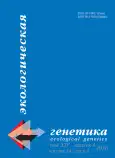Functional analysis of cT-DNAs in naturally transformed plants, recent findings and general considerations
- Authors: Otten L.1
-
Affiliations:
- Institut de Biologie Moléculaire des Plantes
- Issue: Vol 14, No 4 (2016)
- Pages: 26-31
- Section: Articles
- URL: https://journals.rcsi.science/ecolgenet/article/view/5986
- DOI: https://doi.org/10.17816/ecogen14426-31
- ID: 5986
Cite item
Full Text
Abstract
Keywords
Full Text
##article.viewOnOriginalSite##About the authors
Léon Otten
Institut de Biologie Moléculaire des Plantes
Author for correspondence.
Email: leon.otten@ibmp-cnrs.unistra.fr
Russian Federation
References
- Otten L, De Ruffray R. Agrobacterium vitis nopaline Ti plasmid pTiAB4: relationship to other Ti plasmids and T-DNA structure. Mol Gen Genet. 1994;245:493-505. doi: 10.1007/BF00302262.
- Vladimirov IA, Matveeva TV, Lutova LA. Opine biosynthesis and catabolism genes of Agrobacterium tumefaciens and Agrobacterium rhizogenes. Russ J Genet. 2015;51:121-129. doi: 10.1134/S1022795415020167.
- Spena A, Schmülling T, Koncz C, Schell JS. Independent and synergistic activity of rol A, B and C loci in stimulating abnormal growth in plants. EMBO J. 1987;6:3891-3899.
- Nilsson O, Olsson O. Getting to the root: the role of the Agrobacterium rhizogenes rol genes in the formation of hairy roots. Physiol Plant. 1997;100, 463-473. doi: 10.1111/j.1399-3054.1997.tb03050.x.
- Schell J, Van Montagu M, De Beuckeleer M, et al. Interactions and DNA Transfer between Agrobacterium tumefaciens, the Ti-Plasmid and the Plant Host. P Roy Soc Lond B Bio. 1979;204:251-266. doi: 10.1098/rspb.1979.0026.
- White F, Garfinkel D, Huffman GA, et al. Sequences homologous to Agrobacterium rhizogenes T-DNA in the genomes of uninfected plants. Nature. 1983;301:348-350. doi: 10.1038/301348a0.
- Furner IJ, Huffman GA, Amasino RM, et al. An Agrobacterium transformation in the evolution of the genus Nicotiana Nature. doi: 10.1038/319422a0.
- Suzuki K, Yamashita I, Tanaka N. Tobacco plants were transformed by Agrobacterium rhizogenes infection during their evolution. Plant J. 2002;32:775-787. doi: 10.1046/j.1365-313X.2002.01468.x.
- Matveeva TV, Bogomaz DI, Pavlova OA, et al. Horizontal gene transfer from genus Agrobacterium to the plant Linaria in nature. MPMI. doi: 10.1094/MPMI-07-12-0169-R.
- Matveeva TV, Lutova LA. Horizontal gene transfer from Agrobacterium to plants. Front Plant Sci. 2014;11(5):326. doi: 10.3389/fpls.2014.00326.
- Chen K, Dorlhac de Borne F, Szegedi E, Otten L. Deep sequencing of the ancestral tobacco species Nicotiana tomentosiformis reveals multiple T-DNA inserts and a complex evolutionary history of natural transformation in the genus. Nicotiana Plant J. 2014;80:669-682. doi: 10.1111/tpj.12661.
- Kyndt T, Quispe D, Zhai H, et al. The genome of cultivated sweet potato contains Agrobacterium T-DNAs with expressed genes: an example of a naturally transgenic food crop. Proc Nat Acad Sci USA. 2015;112:5844-5849. doi: 10.1073/pnas.1419685112.
- Meyer A, Tempé J, Costantino P. Hairy root: a molecular overview. Functional analysis of Agrobacterium rhizogenes T-DNA genes. In Plant-Microbe Interactions, Vol. 5 (G. Stace, Keen N.T., eds). St. Paul, Minnesota: APS Press; 2000:93-139.
- Chen K, Dorlhac de Borne F, Julio E, et al. Root-specific expression of opine genes and opine accumulation in some cultivars of the naturally occurring GMO Nicotiana tabacum. Plant J. 2016; in press.
- Levesque H, Delepelaire P, Rouzé P, et al. Common evolutionary origin of the central portion of the Ri TL-DNA of Agrobacterium rhizogenes and the Ti T-DNAs of Agrobacterium tumefaciens. Plant Mol Biol. 1988;11:731-744. doi: 10.1007/BF00019514.
- Aoki S, Syono K. Function of Ngrol genes in the evolution of Nicotiana glauca conservation of the function of NgORF13 and NgORF14 after ancient infection by an Agrobacterium rhizogenes-like ancestor. Plant Cell Physiol. 1999;40:222-230. doi: 10.1093/oxfordjournals.pcp.a029531.
- Fründt C, Meyer AD, Ichikawa T, Meins F. A tobacco homologue of the Ri-plasmid orf13 gene causes cell proliferation in carrot root disks. Mol Gen Genet. 1998;259:559-68. doi: 10.1007/s004380050849.
- Mohajjel-Shoja H, Clément B, Perot J, et al. Biological activity of the Agrobacterium rhizogenes-derived rolC gene of Nicotiana tabacum and its functional relationship to other plast genes. MPMI. 2011;24:44-53. doi: 10.1094/MPMI-06-10-0139.
- Darwin C. On the Origin of Species by Means of Natural Selection, or the Preservation of Favoured Races in the Struggle for Life, London, John Murray. 1859.
- Baek CH, Farrand SK, Park DK, et al. Genes for utilization of deoxyfructosyl glutamine (DFG), an amadori compound, are widely dispersed in the family Rhizobiaceae. FEMS Microbiol Ecol. 2005;53:221-233. doi: 10.1016/j.femsec.2004.12.008.
Supplementary files







